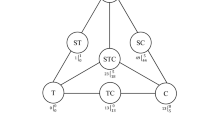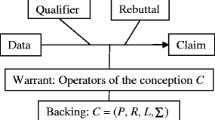Abstract
Inside the discipline, mathematical work consists of the interplay between stating and refining conjectures and attempting to prove those conjectures. However, the mathematical practices of conjecturing and proving are traditionally separated in high school geometry classrooms, despite some research showing that students can successfully navigate the interplay between the two. In this manuscript, we share perspectives from secondary mathematics teachers regarding what conjecturing and proving look like in geometry classrooms and possible rationales for why they are separated. We document that from the teachers’ perspective, the activities of conjecturing and proving have different goals, draw on different resources, and require different actions from students. In teachers’ eyes, these differences necessitate the separation of conjecturing and proving. By understanding teachers’ perspectives on the activities of conjecturing and proving, we can better consider the constraints of the classroom environment and possibly design activities in which conjecturing and proving could be reunited to allow students a more authentic mathematical experience.
Similar content being viewed by others
Notes
In this manuscript, we use normal and normally to mean that something accords with instructional norms.
We use figure to refer to the mathematical concept about which properties are ascribed, or the object of semiosis. We use diagram to refer to the graphical artifact transacted in semiosis (see also Herbst et al. 2017, Chapter 2).
The animations designed as part of this research project, including The Square, can be viewed as part of the original collection in LessonSketch (www.lessonsketch.org).
All names used here are pseudonyms.
It is worth noting for international readers that in the USA geometry is taught in a single course of high school studies that students take in their 9th or 10th grade; experienced geometry teachers are teachers with experience teaching this course.
Each session was attended by at least two members of the research team. A facilitator ensured the smooth running of the session and the comfort of the participants. A provocateur ensured that the conversation would yield data that would inform research questions, at times pressing participants to say more on topics in ways that are not generally allowed in conversation. For more information on the design of the focus groups please, see Nachlieli and Herbst (2010), also Nachlieli (2011).
All animated students’ names are Greek letters.
References
Balacheff, N. (1988). Aspects of proof in pupils' practice of school mathematics. In D. Pimm (Ed.), Mathematics, teachers, and children (pp. 216–238). London: Hodder and Stoughton.
Ball, D. L., & Bass, H. (1999). Making believe: The collective construction of public mathematical knowledge in the elementary classroom. Yearbook-National Society for the Study of Education, 1, 193–224.
Ball, D. L., & Bass, H. (2003). Making mathematics reasonable in school. In J. Kilpatrick, W. G. Martin & D. Schifter (Eds.), A research companion to Principles and Standards for School Mathematics (pp. 27–44). Reston, VA: National Council of Teachers of Mathematics.
Bieda, K. N. (2010). Enacting proof-related tasks in middle school mathematics: Challenges and opportunities. Journal for Research in Mathematics Education, 41, 351–382.
Boero, P., Garuti, R., & Mariotti, M. A. (1996). Some dynamic mental processes underlying producing and proving conjectures. In Proceedings of the 20th conference of the International Group for the Psychology of Mathematics Education PME-XX (Vol. 2, pp. 121–128). Valencia.
Byers, W. (2010). How mathematicians think: Using ambiguity, contradiction, and paradox to create mathematics. Princeton, NJ: Princeton University Press.
Chazan, D. (1993). High school geometry students’ justification for their views of empirical evidence and mathematical proof. Educational Studies in Mathematics, 24(4), 359–387.
Chazan, D., & Herbst, P. (2012). Animations of classroom interaction: Expanding the boundaries of video records of practice. Teachers’ College Record, 114, 1–34.
Chazan, D., & Lueke, H. M. (2009). Exploring tensions between disciplinary knowledge and school mathematics: Implications for reasoning and proof in school mathematics. In D. Stylianou, E. Knuth, & M. Blanton (Eds.), Teaching and learning mathematics proof across the grades (pp. 21–39). Hillsdale, NJ: Erlbaum.
Davis, P. J., & Hersh, R. (1998). The mathematical experience. Boston: Houghton Mifflin Harcourt.
Doyle, W. (1983). Academic work. Review of Educational Research, 53(2), 159–199.
Ellis, A. B. (2007). Connections between generalizing and justifying: Students’ reasoning with linear relationships. Journal for Research in Mathematics Education, 38(3), 194–229.
Ellis, A. B., Lockwood, E., Williams, C. C. W., Dogan, M. F., & Knuth, E. (2012). Middle school students’ example use in conjecture exploration and justification. In Proceedings of the 34th Annual Meeting of the North American Chapter of the Psychology of Mathematics Education. Kalamazoo, MI: Western Michigan University.
Empson, S. B., & Jacobs, V. R. (2008). Learning to listen to children’s mathematics. In D. Tirosh & T. Wood (Eds.), Tools and processes in mathematics teacher education (pp. 257–281). Rotterdam, NL: Sense Publishers.
Healy, L., & Hoyles, C. (2000). A study of proof conceptions in algebra. Journal for Research in Mathematics Education, 31(4), 396–428.
Herbst, P. (2006). Teaching geometry with problems: Negotiating instructional situations and mathematical tasks. Journal for Research in Mathematics Education, 37, 313–347.
Herbst, P., Aaron, W., Dimmel, J., & Erickson, A. (2013a). Expanding students’ involvement in proof problems: Are geometry teachers willing to depart from the norm? In Paper presented at the 2013 meeting of the American Educational Research Association. Deep Blue at the University of Michigan. http://hdl.handle.net/2027.42/97425.
Herbst, P., & Brach, C. (2006). Proving and ‘doing proofs’ in high school geometry classes: What is ‘it’ that is going on for students and how do they make sense of it? Cognition and Instruction, 24, 73–122.
Herbst, P., & Chazan, D. (2003). Exploring the practical rationality of mathematics teaching through conversations about videotaped episodes: The case of engaging students in proving. For the Learning of Mathematics, 23(1), 2–14.
Herbst, P., Chen, C., Weiss, M., González, G., with Nachlieli, T., Hamlin, M., & Brach, C. (2009). “Doing proofs” in geometry classrooms. In M. Blanton, D. Stylianou, & E. Knuth (Eds.), Teaching and learning of proof across the grades: A K-16 perspective (pp. 250–268). New York: Routledge.
Herbst, P., Fujita, T., Halverscheid, S., & Weiss, M. (2017). The learning and teaching of secondary school geometry: A modeling perspective. New York: Routledge.
Herbst, P., with González, G., Hsu, H. Y., Chen, C., Weiss, M., & Hamlin, M. (2010). Instructional situations and students’ opportunities to reason in the high school geometry class. Manuscript. Deep Blue at the University of Michigan. http://hdl.handle.net/2027.42/78372.
Herbst, P., & Kosko, K. (2014). Using representations of practice to elicit mathematics teachers’ tacit knowledge of practice: A comparison of responses to animations and videos. Journal of Mathematics Teacher Education, 17(6), 515–537.
Herbst, P., Kosko, K., & Dimmel, J. (2013b). How are geometric proof problems presented? Conceptualizing and measuring teachers’ recognition of the diagrammatic register. In M. Martinez & A. Castro Superfine (Eds.), Proceedings of the 35th annual meeting of the North American Chapter of the International Group for the Psychology of Mathematics Education (pp. 179–186). Chicago, IL: University of Illinois at Chicago. Deep Blue at the University of Michigan. http://hdl.handle.net/2027.42/97761.
Herbst, P., Nachlieli, T., & Chazan, D. (2011). Studying the practical rationality of mathematics teaching: What goes into “installing” a theorem in geometry? Cognition and Instruction, 29(2), 218–255.
Kilpatrick, J., Swafford, J., & Findell, B. (2001). Adding it up: Helping children learn mathematics. Washington, DC: National Academies Press.
Knuth, E. J., Choppin, J., & Bieda, K. (2009). Middle school students’ production of mathematical justifications. In D. Stylianou, M. L. Blanton, & E. J. Knuth (Eds.), Teaching and learning proof across the grades: A K-16 perspective (pp. 153–170). New York: Routledge.
Kuzniak, A., Tanguay, D., & Elia, I. (2016). Mathematical working spaces in schooling: an introduction. ZDM, 48(6), 721–737.
Lakatos, I. (1976). Proofs and refutations: The logic of mathematical discovery. Cambridge, UK: Cambridge University.
Lemke, J. L. (1990). Talking science: Language, learning, and values. Norwood, NJ: Ablex.
Mariotti, M. A. (2006). Proof and proving in mathematics education. In A. Gutierrez & P. Boero (Eds.), Handbook of research on the psychology of mathematics education: Past, present and future (pp. 173–204). Rotterdam: Sense.
Martinez, M. V., & Pedemonte, B. (2014). Relationship between inductive arithmetic argumentation and deductive algebraic proof. Educational Studies in Mathematics, 86(1), 125–149.
Mason, J. (2011). Noticing: Roots and branches. In M. G. Sherin, V. R. Jacobs, & R. A. Philipp (Eds.), Mathematics teacher noticing: Seeing through teachers’ eyes (pp. 35–50). New York: Routledge.
Moore-Russo, D., & Viglietti, J. M. (2011). Teachers’ reactions to animations as representations of geometry instruction. ZDM Mathematics Education, 43(1), 161–173.
Morine-Dershimer, G. (1978). How teachers “see” their pupils. Educational Research Quarterly, 1978–79, 3, 83–99.
Nachlieli, T. (2011). Co-facilitation of study groups around animated scenes: The discourse of a moderator and a researcher. ZDM Mathematics Education, 43(1), 53–64.
Nachlieli, T., & Herbst, P. (2010). Facilitating encounters among teachers with representations of teaching: two registers. Manuscript. Deep Blue at the University of Michigan. http://hdl.handle.net/2027.42/64852.
National Council of Teachers of Mathematics. (2000). Principles and standards for school mathematics. Reston, VA: Author.
National Governors Association Center for Best Practices, Council of Chief State School Officers. (2010). Common core state standards. Washington, DC: Author.
Otten, S., Gilbertson, N. J., Males, L. M., & Clark, D. L. (2014). The mathematical nature of reasoning-and-proving opportunities in geometry textbooks. Mathematical Thinking and Learning, 16(1), 51–79.
Pedemonte, B. (2007). How can the relationship between argumentation and proof be analysed? Educational Studies in Mathematics, 66(1), 23–42.
Poincaré, H. (1910). Mathematical creation. The Monist, 321–335.
Pölya, G. (1945). How to solve it: A new aspect of mathematical method. Princeton: Princeton University Press.
Sherin, M., Jacobs, V., & Philipp, R. (Eds.). (2011). Mathematics teacher noticing: Seeing through teachers' eyes. New York: Routledge.
Sherin, M. G., & van Es, E. A. (2005). Using video to support teachers’ ability to notice classroom interactions. Journal of Technology and Teacher Education, 13(3), 475.
Sowder, L., & Harel, G. (1998). Types of students’ justifications. The Mathematics Teacher, 91(8), 670–675.
Stylianou, D. A. (2013). An examination of connections in mathematical processes in students’ problem solving: Connections between representing and justifying. Journal of Education and Learning, 2(2), 23–35.
Tettegah, S. Y. (2005). Technology, narratives, vignettes, and the intercultural and cross-cultural teaching portal. Urban Education, 40(4), 368–393.
Van Es, E. A., & Sherin, M. G. (2002). Learning to notice: Scaffolding new teachers’ interpretations of classroom interactions. Journal of Technology and Teacher Education, 10(4), 571–595.
Acknowledgements
The authors acknowledge the support of the National Science Foundation through the Grant ESI-0353285 to Patricio Herbst. All opinions are those of the authors and do not necessarily represent the views of the Foundation.
Author information
Authors and Affiliations
Corresponding author
Rights and permissions
About this article
Cite this article
Aaron, W.R., Herbst, P.G. The teacher’s perspective on the separation between conjecturing and proving in high school geometry classrooms. J Math Teacher Educ 22, 231–256 (2019). https://doi.org/10.1007/s10857-017-9392-0
Published:
Issue Date:
DOI: https://doi.org/10.1007/s10857-017-9392-0




